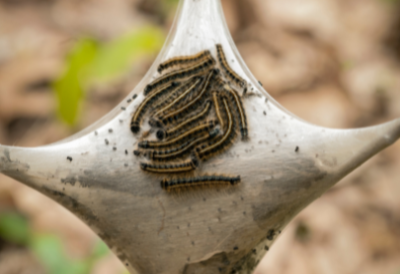For forest tent caterpillar and other insects spraying, call SprayTech at (720)248-0000.
The forest tent caterpillar is another defoliator. It is the larvae form that turns into a moth after going through complete metamorphosis. Understanding more about the
The eggs are laid in masses and are glued to twigs over winter. Then the caterpillars will emerge in the middle of spring. This is the most destructive stage of the lifecycle when it comes to the plant life because caterpillars eat a lot before going into their cocoons.
They then pupate and transform into adult moths in the early summer.
The larvae are distinguishable by their electric blue color. There are also yellow keyhole patterns along the back. When they transform into moths, they are light brown in color and their wings have wavy light markings on them.
The caterpillar will make a home on deciduous trees. You can find them on ash, aspen, fruit trees, poplars, and even willows.
They will chew on the leaves. Due to the short lifecycle, they don’t usually become the biggest pest problem in the area. In fact, you may not even see a problem until they have gone through their metamorphosis. There are a few outbreaks here and there that you will need to look out for.
You’ll be able to tell if there’s a colony based on the lightly spun silk that forms around the trees.
Most caterpillars are handled by nature, which is another reason for them not to end up becoming a major problem to people and plants. Birds, hunting wasps, tachinid flies, and predaceous bugs will naturally take care of a pest problem. There are also various diseases that spread across the caterpillars.
You can use some insecticides on the creatures. Bt is one of the most effective and great for selective control. However, pyrethroids and spinosad are also effective when they come into contact with the caterpillars.
SprayTeck serves El Paso county for tree spraying and noxious weed control. (720)248-0000.
Comments are closed.